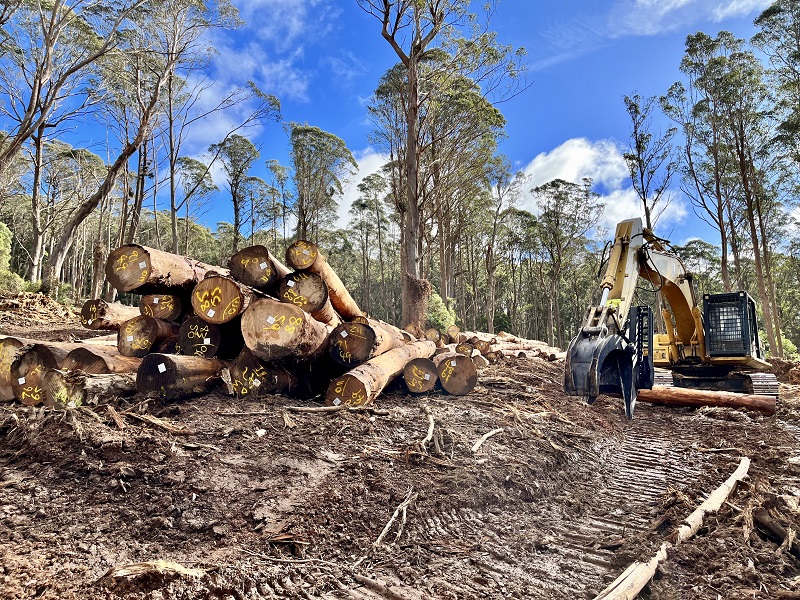The NSW native forest logging industry is unsustainable – a fast transition out is needed now
October 19, 2024
The NSW Government is currently seeking submissions on the future of native forest logging in the state. One option is not on the menu—yet should be. That option is the rapid and permanent exit out of native forest logging and a switch to a plantation-only timber industry in the next 2 years. This is essential because the industry, as it stands, is demonstrably unsustainable. And unsustainable in several key ways.
First, the native forest logging industry is economically unsustainable as it requires significant public subsidy to remain viable. Industry lobbyists have openly admitted it could not persist without major injections of cash from governments. In 2019-2020, NSW Forest Corp received $246.9 million in handouts from government, yet still lost $28.2 million (Frontier Economics 2023). This was not an unusual year. Money spent on propping up the native forest logging industry is money that could otherwise be spent on doctors, nurses, teachers and aged care workers, supporting our health care and education systems that urgently need more investment.
Second, the industry is ecologically unsustainable. Logging is concentrated in areas of high biodiversity value (Ward et al. 2024), where the majority of animals die when a forest is logged. The recovery of populations and the habitats on which they depend may take centuries. Recent research in NSW demonstrates that each area proposed for logging supports habitat for many threatened species, many of which have already lost large amounts of their original habitat due to historical land clearing (Ward et al. 2024).
Third, the native forest logging industry is unsustainable because it makes forests more fire prone. Fire severity in logged and regenerated forests is always significantly higher in logged forests than it is in intact forests (Lindenmayer et al. 2022). This pulse of increased flammability lasts for 40-70 years after a forest has been logged and then regenerated (Wilson et al. 2022). This pulse of elevated fire severity poses several dangers. One is the increased risk of high severity wildfire which is a major threat to both human communities and populations of native animals. A second is that logging-induced fire risks make it is unlikely that regenerated forests will remain unscathed by wildfire long enough to mature into a sawlog-producing stands. Research shows that for tall, wet forests, the frequency of fire is now so high that there is an 80% chance that the forest will burn before it reaches 80 years old—the age required for sawlog production (Cary et al. 2021). By contrast, plantations are four times less flammable than logged and regenerated native forests. This makes them a far more suitable source of timber. In addition, plantations can produce nine harvests - 3 clearcuts and 6 thinning operations over three rotation periods in the same 75-80 years it takes to grow just one crop of native forest sawlogs. Importantly, the vast majority of Australia’s sawn timber (approximately 90%) already comes from plantations, which supply wood for roof trusses, floor boards and furniture.
The environmental costs of native forest logging also extend to greenhouse gas emissions. Logging generates significant emissions, not only at the time of logging, but also from short-lived wood products like wood chips, paper pulp and packaging (Keith et al. 2014b). These products either end up being burned or sent to landfill, where they continue to generate greenhouse gas emissions. In contrast, the most effective way to store carbon in our landscapes is to ensure that native forests remain intact. That is, by not logging them. Even when forests are burnt in a wildfire (Keith et al. 2014a), the vast amount of carbon remains sequestered, and the emissions from wildfire are significantly lower than those produced by logging.
In summary, native forest logging is unsustainable. It is bad for the economy, bad for biodiversity, bad for climate risks, and bad for fire risks. The best course of action for the NSW Government in its review of the native forest logging industry is to quickly bring it to a close. Our analysis based on the size of the industry, the small number of direct jobs, and the churn in employment numbers suggests that the transition to a plantation-only industry should be no more than two years – enough time to provide exit packages and appropriate employment programs that do not involve further logging.
References
Cary, G., W. Blanchard, C. N. Foster, and D. B. Lindenmayer. 2021. Effects of altered fire regimes on critical timber production and conservation rotations. International Journal of Wildland Fire 30:322-328.
Frontier Economics. 2023. Public native forest logging: a large and growing taxpayer burden. Frontier Economics, Melbourne, Victoria.
Keith, H., D. B. Lindenmayer, B. G. Mackey, D. Blair, L. Carter, L. McBurney, S. Okada, and T. Konishi-Nagano. 2014a. Accounting for biomass carbon stock change due to wildfire in temperate forest landscapes in Australia. PLOS One 9:e107126.
Keith, H., D. B. Lindenmayer, B. G. Mackey, D. Blair, L. Carter, L. McBurney, S. Okada, and T. Konishi-Nagano. 2014b. Managing temperate forests for carbon storage: impacts of logging versus forest protection on carbon stocks. Ecosphere 5(6):Art. 75. [online]
Lindenmayer, D. B., P. Zylstra, R. Kooyman, C. Taylor, M. Ward, and J. E. M. Watson. 2022. Logging elevated the probability of high-severity fire in the 2019–20 Australian forest fires. Nature Ecology & Evolution 6:533-535.
Ward, M., K. Ashman, D. B. Lindenmayer, S. Legge, G. Kindler, T. Cadman, R. Fletcher, N. Whiterod, M. Lintermans, P. Zylstra, R. Stewart, H. Thomas, S. Blanch, and J. E. Watson. 2024. Shifting baselines clarify the impacts of contemporary logging on forest-dependent threatened species. Conservation Science and Practice 6:e13185.
Wilson, N., R. Bradstock, and M. Bedward. 2022. Disturbance causes variation in sub-canopy fire weather conditions. Agricultural and Forest Entomology 323:109077.
